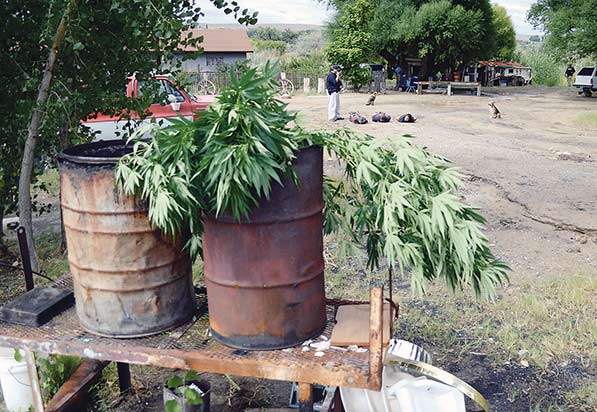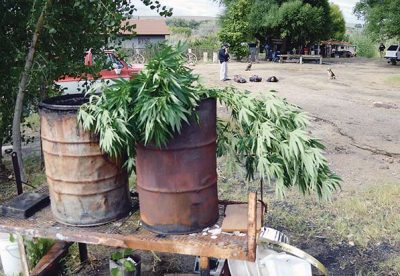
DWI case illustrates complicated jurisdiction issues

Navajo Times | Donovan Quintero An undercover Navajo police officer with the Navajo Nation Police Drug and Gang Task Force calls in for back up while keeping three suspects detained during an operation against drug dealers in this Aug. 2012 photo in Upper Fruitland, New Mexico. Marijuana plants can be seen stuffed in a trash can.
Editor’s note: This is the third in a series on law enforcement issues on the Navajo Nation.
WINDOW ROCK
When a drunk driver crossed the state line to the reservation, the question of jurisdiction became an issue. But it gets complicated when the sovereign immunity of a tribal member is violated by a police officer working with an outside law enforcement agency that does not have an agreement with a tribal government.

Navajo Times | Donovan Quintero
An undercover Navajo police officer with the Navajo Nation Police Drug and Gang Task Force calls in for back up while keeping three suspects detained during an operation against drug dealers in this Aug. 2012 photo in Upper Fruitland, New Mexico. Marijuana plants can be seen stuffed in a trash can.
The National Criminal Justice Association Center for Justice Planning states that an agreement between a tribe and an outside agency ”provides policy guidance for establishing and maintaining intergovernmental collaborative strategies in various areas to improve public safety.” While the Fourth Amendment defines a clear picture on a police’s investigative power – “Police officers stop a person for investigative purposes where … the officers have a reasonable and objective basis for suspecting that particular person is engaged in criminal activity” – but because the U.S. recognizes tribes’ inherent sovereignty, the power to investigate a crime in Indian Country can only be done by a tribal police officer or law enforcement officer who is commissioned by a tribe.
Phillip Francisco, chief of the Navajo Nation Police, showed the Navajo Times a binder filled with outdated and current agreements with law enforcement agencies that surround the reservation.
One of those agencies, the San Juan County Sheriff’s Office in Aztec, has an MOU, which gives undercover deputies with the Four Corners Safety Streets Violent Gang Task Force authority to assist in drug- and gang-related work on the reservation. San Juan County – not the sheriff’s office – is also listed, as having a mutual aid agreement that says both would provide police officers to man a substation. But neither of the agreements says the sheriff’s office would provide for the orderly, efficient, and effective enforcement of the criminal and traffic laws of the Navajo Nation.
To read the full article, pick up your copy of the Navajo Times at your nearest newsstand Thursday mornings!
Are you a digital subscriber? Read the most recent three weeks of stories by logging in to your online account.








 Highway 264,
Highway 264, I-40, WB @ Winslow
I-40, WB @ Winslow